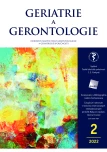Drug interactions in gerontopsychiatry – the choice of antipsychotics and antidepressants for geriatric patients
Authors:
Jana Michalcová 1,2; Ivana Tašková 1,2; Katarína Bielaková 3,4
Authors‘ workplace:
Ústav aplikované farmacie, Farmaceutická fakulta MU Brno
1; Pracoviště klinické farmacie, Psychiatrická nemocnice Bohnice, Praha
2; Klinika interní, geriatrie a praktického lékařství LF MU a FN Brno
3; Ústav farmakologie LF MU a FN Brno
4
Published in:
Geriatrie a Gerontologie 2022, 11, č. 2: 61-67
Category:
Review Article
Overview
When different drugs are combined, drug interactions may lead to increased or decreased effect of the pharmacotherapy. Each drug may interact with another drug, dietary supplement, or food ingredient. Drugs overlap in their receptor profile via pharmacodynamic interaction, or target drug concentrations may be affected via pharmacokinetic interaction. Increased concentrations of the drug manifest in adverse drug reactions, whereas decreased concentrations of the drug in plasma result in ineffective treatment. In both cases, drug interaction is a very undesirable phenomenon we try to prevent, because it causes prolonged hospitalization, worsens quality of life of geriatric patients and increases health care costs. Prevention and elimination of drug interactions are objectives of safe pharmacotherapy. This article describes basic drug interactions in gerontopsychiatry, focusing specifically on antipsychotics and antidepressants. The article provides information about substrates, inhibitors and inducers of cytochrome P450. Furthermore, it presents the need for multidisciplinary cooperation of the physician and clinical pharmacist to solve drug interactions. In addition, examples of drug interactions are demonstrated using case reports from clinical practice, as experienced by geriatric patients.
Keywords:
antidepressants – geriatric patient – Antipsychotics – Drug interactions – psychiatry
Sources
1. Kehusmaa S, Autti-Rämö I, Helenius H, et al. Factors associated with the utilization and costs of health and social services in frail elderly patients. BMC Health Serv Res 2012; 12 (1): 204.
2. Lehnert T, Heider D, Leicht H, et al. Review: Health Care Utilization and Costs of Elderly Persons With Multiple Chronic Conditions. Med Care Res Rev 2011; 68 (4): 387–420.
3. Chen Y, Zhu L, Zhou Q. Effects of drug pharmacokinetic/ pharmacodynamic properties, characteristics of medication use, and relevant pharmacological interventions on fall risk in elderly patients. Ther Clin Risk Manag 2014; 10 : 437–448.
4. Ambrose AF, Paul G, Hausdorff JM. Risk factors for falls among older adults: a review of the literature. Maturitas 2013; 75(1): 51–61.
5. Medication safety in polypharmacy: technical report. World Health Organization online. Dostupné z: https://www.who.int/publications - detail-redirect/medication-safety-in-polypharmacy-technical - report
6. Grundmann M. Problematika s podáváním léků ve stáří – II. nežádoucí účinky léků. Interní Med 2001; 3(2): 82–83.
7. Suchý D, Hromádka M. Příspěvek k problematice geriatrické farmakoterapie. Prakt Lékáren 2011; 7(3): 111–114.
8. Krombholz R, Drástová H. Polypragmázie – neblahý fenomén nejen v gerontopsychiatrii. Interní Med 2013; 15(8–9): 263 – 265.
9. Ereshefsky L, Jhee S, Grothe D. Antidepressant Drug-Drug Interaction Profile Update. Drugs R D 2005; 6(6): 323–336.
10. Gonzaga de Andrade Santos TN, Medonça da Cru Macieira G, Cardoso Sodré Alves BM, et al. Prevalence of clinically manifested drug interactions in hospitalized patients: A systematic review and meta-analysis. PLoS One 2020; 15(7): e0235353.
11. Akamine Y, Yasui-Furukori N, Ieri I, et al. Psychotropic Drug–Drug Interactions Involving P-Glycoprotein. CNS Drugs 2012; 26(11): 959–973.
12. Zanger UM, Schwab M. Cytochrome P450 enzymes in drug metabolism: Regulation of gene expression, enzyme activities, and impact of genetic variation. Pharmacol Ther 2013; 138(1): 103–141.
13. Mohr P, Kopeček M, Brunovský M, et al. Klinická psychofarmakologie, 2017.
14. Prokeš M, Suchopár J. Lékové interakce v psychiatrii-teorie a praxe. Psychiatrie pro praxi 2015; 16(2): 51–55.
15. Tašková I. Psychofarmaka v kazuistikách. 2021.
16. Češková E. Treatment of depressive disorder with cognitive dysfunction. Psychiatrie pro praxi 2017; 18(2): 60–63.
17. Bielaková K, Matějovská Kubešová H. Trends in pharmacotherapy for elderly patients. Prakt Lékáren 2018; 14(1): 8–10.
18. Rollason V, Vogt N. Reduction of Polypharmacy in the Elderly: A Systematic Review of the Role of the Pharmacist. Drugs Aging 2003; 20(11): 817–832.
19. Caffiero N, Delate T, Ehizuelen MD, et al. Effectiveness of a Clinical Pharmacist Medication Therapy Management Program in Discontinuation of Drugs to Avoid in the Elderly. J Manag Care Spec Pharm 2017; 23(5): 525–531.
20. Michalcova J, Vašut K, Airaksinen M, et al. Inclusion of medication - -related fall risk in fall risk assessment tool in geriatric care units. BMC Geriatr 2020;20 : 454.
21. Tašková I. Terapeutické monitorování psychofarmak z pohledu klinického farmaceuta: doporučení versus praxe. Remedia 2020; 30 : 650–656.
22. Mayerová M, Horská K, Ustohal L. Klozapin: moderní antipsychotikum s dlouhou tradicí. Praha: Galén 2021.
23. Lutz UC, Sirfy A, Wiatr G, et al. Clozapine serum concentrations in dopamimetic psychosis in Parkinson’s disease and related disorders. Eur J Clin Pharmacol 2014; 70(12): 1471–1476.
24. Suchopár J. Kompendium lékových interakcí Infopharm 2005; Praha: Infopharm 2004.
25. Rudolph JL. The Anticholinergic Risk Scale and Anticholinergic Adverse Effects in Older Persons. Arch Intern Med 2008; 168(5): 508.
Labels
Geriatrics General practitioner for adults Orthopaedic prostheticsArticle was published in
Geriatrics and Gerontology

2022 Issue 2
- Metamizole at a Glance and in Practice – Effective Non-Opioid Analgesic for All Ages
- Memantine in Dementia Therapy – Current Findings and Possible Future Applications
- Advances in the Treatment of Myasthenia Gravis on the Horizon
- Hope Awakens with Early Diagnosis of Parkinson's Disease Based on Skin Odor
Most read in this issue
- Non-melanoma skin tumors – basalioma, spinalioma. Overview of the disease and treatment
- Midline catheters for geriatric patients in Postacute Care Facility
- Drug interactions in gerontopsychiatry – the choice of antipsychotics and antidepressants for geriatric patients
- Urinary incontinence in old age
